Plants are boring.
<h4>I mean, they just sit there, right?</h4>
Who knew that I would graduate with a degree and then a PhD in plant science at the University of Manchester after first looking at the course in the prospectus and thinking: “who the hell would study that”?
But then, a series of lectures by Prof Elizabeth Sheffield (now at the University of Liverpool) in her series on “Biodiversity” really switched me on to the wonders of the botanical world - this, despite having to fight against the perpetual hangover that accompanies the first year of a UK bachelor’s degree and concomitant lectures at 10am.
From videos of dodder twisting around and penetrating nettles to suck them dry (not good at all for a hangover), to tales of stinky ginkgo and towering lycophytes - the first trees and the origin of coal - plants no longer seemed dull but utterly fascinating.
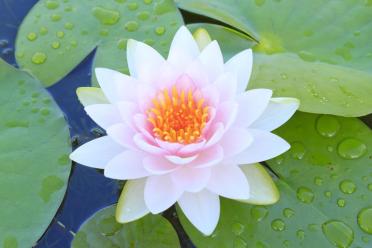

Torture victims begin to recover when they spend time outside in a garden with flowers. So we need them, in some deep psychological sense, which I don’t suppose anybody really understands yet.

- Jane Goodall
It also helped that we had some excellent greenhouses at the University of Manchester FIRS, as well as some really exciting plant science research going on, covering a range of aspects from photosynthesis to metal transport, pollution and more.
Anyway - after my first year being non-commital and studying “Biological Sciences”, I made the shift to study a subject that inspires me more than any other.


Let food be thy medicine and medicine be thy food.

I often heard derisory comments from other fields of biology, especially as an early career researcher. Indeed, plant science is a vastly underrepresented course in universities, despite the fact that it is by far the most crucial topic when it comes to keeping civilisation going.
It’s the whole reason civilisation can exist in the first place. Sure, cancer research is trendy, but people only become old (the main cause of cancer) if they’re well fed and well nourished (and have received decent medical treatment, ample vaccinations and occasional bouts of antibiotics in extreme cases, of course).
Just how would we feed ourselves without rice, wheat, maize, yams, potatoes, bananas, oats, carrots, turnips, olives, tomatoes, beans, cabbage, cucumbers, squash, cauliflower, mangos, melons, coconuts, aubergines, courgettes, peanuts, cashews…? I’ll stop now.
But plants are the source of much more than weetabix.
Understanding plants, how they work and how they affect us, is as important as any of the work on our own species. The right diet can allay a swathe of ailments. The right plant can heal us better than any synthetic drug. Plant factories will also become the sustainable method of biomanufacture of medicines and compounds of the future.
In fact, with 50 000 secondary metabolites being made between them, plants are an almost inexhaustible source of material to help us in abundant ways.
For now, however, let’s just appreciate the incredible diversity and fascinating biology of plants as it is, which is what really swayed me in the first place.
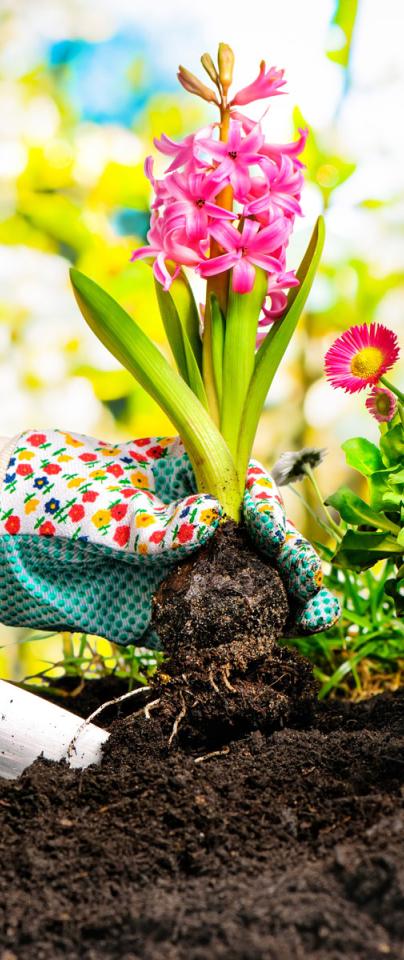

Gardens are not made by singing ‘Oh, how beautiful’, and sitting in the shade.

This is precisely why plants (to me) are so interesting and impressive.
They don’t even have to move. Some of them are older than most of the documented human civilisations yet they haven’t budged from the spot. How on earth? Animals are always on the move, mostly, corals and weird sea worms aside, looking for food, avoiding predators, trying to stay warm, etc.
Plants just take it all: sun, rain, hail, disease, lightning, aphids, giraffes, other plants.
Ok, some move. There are plants - such as a type of selaginella, a resurrection plant - which can dry up almost completely and then get blown about in the desert breeze, only to come back to life, so to speak, upon reintroduction to water.
But most just sit there.
Think of those 4000 year old (+) bristlecone pines in the high mountains of Western North America, or the several thousand year old cypress and olive trees in the Mediterranean. They’ve seen a lot in their time, but robustly splay their knotted old branches in defiance against the elements, soaking up whatever they need from their complex web of awesomeness in the soil.
Like an iceberg, what you see on top - as beautiful and magnificent as those leaves, stems, branches and flowers are - is matched by the sprawling, sometimes deep-burrowing, root system that tethers and feeds many of our plants.
What they do with those roots is enthralling. 97% (or more) of all land plants live in harmony with an abundant subterranean complex of fungi and bacteria that intertwine and interdine with them. Via this network of microbes, plants are connected, often, in an intricate mycelial web that allows them to communicate with one another - sending signals that danger is coming, or sharing nutrients.
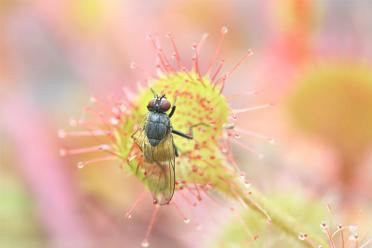

The fairest thing in nature, a flower, still has its roots in earth and nature.

- D.H. Lawrence
Never fear.
Plants have adapted in such a way that enables them to tolerate - or even thrive - in nutrient poor conditions. Low nitrogen, why not just eat a frog? This is the case for the carnivorous plants, at least, which live in nitrogen-poor soils such as bogs or in certain rainforests where competition for nutrients is pretty fierce.
They’re a strange group, prompting cultural classics such as the Little Shop of Horrors and the Day of the Triffids.
Indeed, if you get a carnivorous plant and grow it in a high nitrogen soil, it probably won’t make so many traps. They’re not for show.
From venus flytraps to pitcher plants, sundews and the bizarre bladderworts, the variety in how carnivorous plants trap their prey is very exciting. One plant, the “fastest plant in the world”, is a sundew which leaves a leaf on the ground that acts as a catapult. When triggered by a wandering insect, the leaf flings the unsuspecting prey into its sticky fingers of death, which then wrap around and consume it with digestive enzymes not dissimilar to those in your stomach.
Some, such as the rat-eating plant named after David Attenborough, Nepenthes attenboroughii, eats rather larger prey than small, six-legged wanderers.
Carnivory isn’t the only way to get your protein fix, however.
Legumes, such as peas and clover, have worked out a handy arrangement with bacteria that help them to “fix” nitrogen from the air. This is a biological phenomenon that has helped farmers reinvigorate soils for many centuries in crop rotation systems (a practice invented in Belgium and made common in Norfolk by Charles Townsend).
There’s so much nitrogen in the air that deficiency shouldn’t really be an issue. Indeed, some enterprising students (about 14 at the time) from Ireland discovered that cereal plants can adopt these bacteria - Rhizobium - which can be triggered simply by flavonoids after coating seeds. Growing cereals with these bacteria made them sprout faster and almost double in yield. Not bad for a school experiment!
Plants also exude a variety of compounds to ensure that they get the right blend of nutrients they need to survive. If metal ions are bound in the soil, they can release things such as sugars, amino acids, organic acids and phenols which help them manipulate their own soil environment to make it more favourable for nutrient uptake.
We are even using this potential of plants to our own advantage - in the phytoremediation of toxic soils. Essentially, using the ability of plants to clear up the poisons we have left behind due to industrial activities, including heavy metals such as cadmium.

In many environments, take away the ants and there would be partial collapses in many of the land ecosystems.

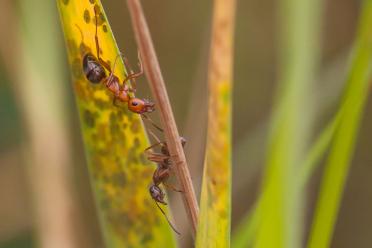
Plant symbiosis doesn’t stop at bacteria and fungi.
Where there are plants, there are often ants. Indeed, in the bromeliads (we’ll come back to those later in the epic epiphytes section), you will often see ants living inside them, feasting on whatever lives within.
Some plants, however, have developed a particularly interesting symbiosis with ants - which even have a special name (completely impossible to remember): Myrmecophyte (the plant that is).
These plants, which exist in a variety of environments, have a special structure which appears to be adapted just for the purpose: Domatia.
A fabulous example is the Cecropia plants, some of which get almost all of their nitrogen from ant faeces. These remarkable trees are a major pioneer species of tree, with most species found littering the Andes mountains in the north of South America.
The species Cecropia pachystachya, for example, lives along with Azteca ants, which eat special food bodies produced by the plants for the ants to graze, in turn being protected from herbivory by marauding ant defenders.
This type of relationship is hardly rare. In fact, it’s quite normal in various groups of plants, including the acacia trees of central America, which harbour Pseudomyrmex ferrugineus ants in the hollows of their big, swollen thorns. Not only do these ants protect the plants from herbivory, they also seem to reduce the harmful effects of leaf pathogens.

If you surrendered to the air, you could ride it.

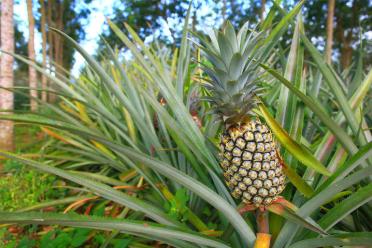
Staying in the forested regions of South America, we were fortunate enough to see many a Cecropia on a field trip to Ecuador (top reason to study plant science - rainforest adventures), while doing a research project on a different type of plant, Bromeliads.
There is a very famous bromeliad available in fruit salads and piña coladas worldwide, which, in every language in the world apart from English is seemingly called ananas, or some derivative thereof (though the Spanish adopted both, which is nice for tourists).
Looking nothing like a pine cone, nor an apple, it’s a very popular fruit.
We studied bromeliads mainly because of their strange lifestyle - living high up in the branches of trees - away from soil, sunlight, or anything particularly necessary for plant growth, it would seem.
However, thrive they do, and grow row after row of rosette leaves, which help them to form a central reservoir, trapping water, leaves and a host of animals to individual mini ecosystems. We found that, in just ten individual bromeliads (they were hard to get hold of, 10 metres up a tree), there were well over 150 species represented - from snakes and frogs to ants, worms (how did they get up there?!) and even “species X” (no-one had a clue what species X was. We may never find out. It was a small, yellow larva that was neither fly, nor caterpillar, nor beetle, nor anything resembling any insect apart from its weird self).
These are plants that belong to the “epiphytes” - plants that live without soil (and apparently very few roots). Utter madness. It goes against everything you thought a plant would need.
More iconic plants that have a similar niche are the orchids, the second-most species-rich family of plants on earth, many of which need absolutely no soil whatsoever, surviving merely on dew, rainwater and runoff of nutrients from tree branches. Some enterprising orchids have also adapted to parasitize a fungus, their seeds being so small and lacking nutrients that they can only survive if cultivated in its presence.
What a world we live in!


On the subject of flowers, they’re quite the topic of debate (and bafflement) in the evolution world. Charles Darwin himself, the more famous among the champions of natural selection, called the evolution of flowering plants his “abominable mystery”.

It’s really quite exciting to learn science at university, when you come to realise that, amidst all that we purport to know, we have barely even scratched the surface on many topics. Half of the things you get taught, you find that your next employer disagrees with. How wonderful!
(It’s important to note here that when there is a consensus in science, such as with climate change, or evolution, we can be pretty happy that this is a real thing. Not a drill. Stop drilling for oil.)

The rapid development as far as we can judge of all the higher plants within recent geological times is an abominable mystery.

There’s no consensus on the abominable mystery, much like there is no consensus on what, exactly, would be the highest possible height for a tree. What even is the limit to tree height? Is it water transport? Maybe.
How old could a bristlecone pine become? How long could a Norway spruce survive, sprouting new stems up from ancient root systems? How do trees manage to maintain such a genetically perfect set of stem cells for thousands of years in their meristem?
Why do leaves turn yellow, orange and red in autumn? Do we have a definitive answer? Some would say no.
Do we need to know? Possibly not. But it’s nice to find out.
Where did flowers come from? Possibly seed ferns, possibly not. Were the first flowering plants trees, like magnolia? Sprawling shrubs like amborella? Water lilies? (I’m picking plants from the base of the flowering plant phylogenetic tree).
Who knows? Plants don’t preserve much in fossils, unless we’re burning them.

I was never a good looking bloke. Not by a long chalk.

- Rod Stewart

Back to the subject of plants just sitting there, not really caring about Darwin or abominable mysteries, partying whether or not it’s September.
Rain, wind, shine, freezing, UV, salt, predation, disease, cutting, nutrient starvation: all things that can perturb a plant, or not, thanks to calcium (the ions of it, anyway, Ca2+) - the fifth most abundant element in the earth’s crust and a hugely versatile signalling molecule.
Ca2+ is everywhere - in your bones, teeth, the White Cliffs of Dover (as the long dead shells of coccolithophores, algae that still bloom in our oceans each summer and are responsible for most of our oxygen).
There’s so much of it that plants (and us, fungi, algae, all cells, really) keep it at a very low concentration inside the cell, as too much of it can cause problems, mainly death. Small amounts of it are very useful, however, as - over evolutionary time - due to its omnipresence and toxicity, cells have adapted ever more complicated ways of getting calcium into and out of cells.
This means that cells use calcium as a kind-of biochemical Morse Code, with waves of calcium - in specific patterns, in specific cells and parts of cells - dictating how organisms respond to the stresses that come along with life.
This calcium then binds to other proteins, which tell DNA to do something, or tell some other protein to do something which then tells the DNA to do something. Other proteins, at the same time, are removing calcium from the cell, which generates the specific patterns we see (therefore the Morse Code effect).
We’re still working it out - but the evidence is pretty amazing for all of this, genetically and physiologically. I did my PhD on calcium signalling in algae, where I saw huge calcium waves in cells in response to salt stress, which got bigger proportionally with the amount of salt applied.
Each “calcium signal” is controlled by incredibly precise mechanisms, which allows plants to respond, in real time, to a multitude of different signals at once. An aphid gently munching on a stem, while the plant sways in an increasing breeze, the ground becoming more saline as the heat dries the previous day’s flood.
Though, even with calcium signalling giving it the chance to respond, the above stresses all at once would signal a pretty bad day for a plant.


Let’s face it, a nice creamy chocolate cake does a lot for a lot of people; it does for me.

- Audrey Hepburn
Back to food - and without plants we’d still be living in caves, or fending off lions and bears, perhaps living nomadic lives with a few goats and cattle. China gave us rice, Mexico gave us maize, Iran, Turkey, Syria, Jordan and Iraq gave us wheat, barley and rye.
The seeds of cities and stratified societies, life as we know it - from Indus to Babylon, Egypt, Persia, Greece and beyond - all of them founded and maintained on plant-based diets.
Well in advance of 50% of global calories come from wheat: noodles, bread, weetabix. Rice and corn make up most of the rest.
It’s important we learn more about these plants, ever more so in a world still undergoing a population explosion - rapidly hurtling towards 10 billion people by 2050 and looking to increase beyond that.
It’s actually pretty fascinating. At Earlham Institute we sequenced the wheat genome for the first time, which is actually three plants in one - as plants have a proclivity towards hybridisation. In fact, we have contributed various plant genomes in our ten years as an institute, tackling other important crops such as potatoes (and their wild relatives), strawberries and barley.
Learning more about plants - and how truly fascinating they are - is not a fruitless endeavour. The information we glean from diverse species can help us to identify the genetic and physiological mechanisms that might help us breed better, higher yielding and more resilient crops for the future.
As with anything in science - knowing more about how the world works can only serve to make the world a more fascinating place to live. More than merely planting that begonia in the backyard, you might then explain to your visitors how clothing companies have based their waterproof coats on the natural structures of their leaves, which repel raindrops in tropical environments, and provide a material only nature could possibly devise...


At Earlham Institute we sequenced the wheat genome for the first time, which is actually three plants in one - as plants have a proclivity towards hybridisation.
